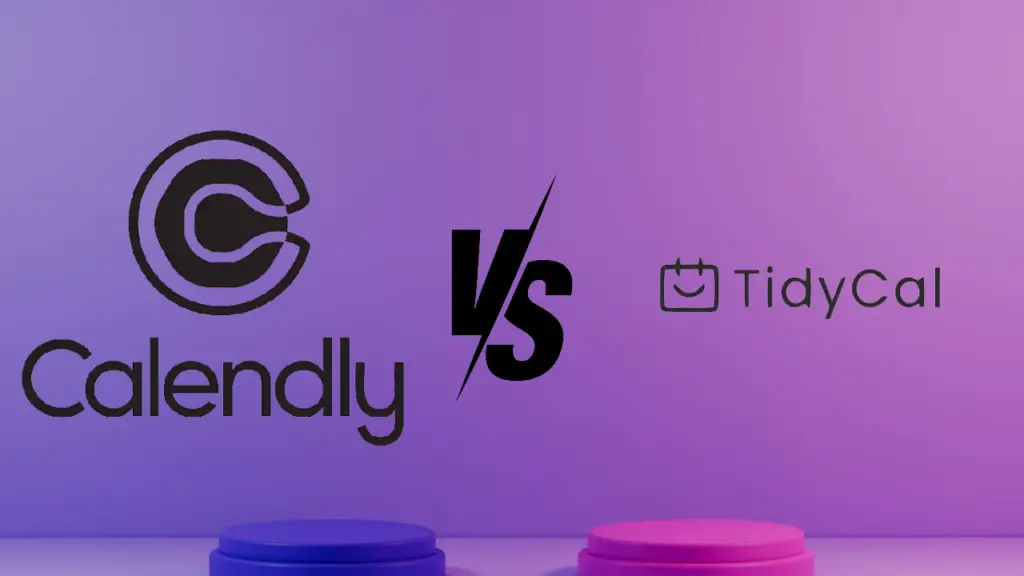In entrepreneurship and content creation, time is your most valuable resource.
Efficient scheduling can distinguish between a productive day and one lost to disorganization.
That’s where online calendar scheduling tools like TidyCal and Calendly come in.
But which one should you choose to streamline your workflow? This blog post has a detailed comparison to help you decide.
Why do we need scheduling tools?
Scheduling tools have changed how we manage appointments, meetings, and events.
These calendar booking tools streamline the appointment booking process and eliminate back-and-forth emails and messages, allowing both parties to find a convenient time with just a few clicks.
They also simplify scheduling meetings by integrating with popular calendar platforms to avoid conflicts or double bookings.
Choosing the right scheduling tool can significantly enhance business efficiency by saving time and reducing administrative tasks.
Calendly

Calendly has been a major player in the scheduling tool market for years.
Launched in 2013, it quickly became the go-to solution for professionals seeking an easy way to manage their appointments.
Calendly’s free plan, known for its historical significance, offers features like automated meeting creation with Google Meet or Zoom, unlimited bookings, and automated event notifications.
Its user-friendly interface, strong integrations, and customization options have solidified its position as an industry leader.
Key features
VCTs stands for Video Conferencing Tools
TidyCal Lifetime Deal

TidyCal, on the other hand, is a newer entrant to the market but has already garnered attention for its cost-effective pricing and straightforward functionality.
The TidyCal Lifetime Deal offers all of TidyCal’s paid features for a one-time payment of $29, making it a more cost-effective choice compared to Calendly’s subscription plans.
TidyCal aims to provide a simple yet powerful solution for scheduling needs without the hefty price tag.
Plus point – TidyCal allows users to create paid-for meetings, providing a way to monetize their services.
Key features
Key features comparison
Free plans
Both TidyCal and Calendly offer free plans, but they differ in features.
Calendly’s free plan is generous, allowing users to connect one calendar, schedule unlimited events, and integrate with Zoom and Google Meet.
TidyCal’s free plan is functional but has limited integrations and customization options.
While Calendly’s free plan supports automated meeting creation with Google Meet or Zoom, TidyCal’s free plan lacks this feature, making it less versatile in comparison.
| Feature | Calendly | TidyCal |
|---|---|---|
| Calendar Connections | Supports multiple calendar connections | Supports major calendars, but no multi-calendar in free plan |
| Appointment Types | More flexibility with customization options | Keeps it simple, appealing to straightforward users |
| Embedding Options | Advanced embedding (inline, pop-up widgets) | Basic embedding, sufficient but lacks advanced options |
| Integrations | Extensive integrations with Zoom, Gmail, Outlook, CRM | Supports essential integrations, lacks breadth of Calendly |
| Notifications & Reminders | Advanced customization (text notifications, custom email templates) | Offers basic notifications and reminders |
| Customization Options | Highly customizable (booking pages, messages, notifications) | Basic customization, focuses on functionality. |
Paid plans
Both TidyCal and Calendly offer paid plans with additional features.
Calendly’s plans start at a higher price point but include advanced features like Zapier integration, team scheduling, and detailed analytics.

TidyCal offers a more cost-effective subscription and a lifetime deal that provides great value for money.

| Feature | Calendly | TidyCal |
|---|---|---|
| Pricing Structures | Monthly and annual subscriptions, starting at $10/user | A lifetime deal for a one-time payment that includes all paid features focused on core functionalities. |
| Value for Money | More advanced features, higher cost with the popular plan (for teams) at $16/month | Lifetime deal for budget-conscious users |
User experience
| Feature | Calendly | TidyCal |
|---|---|---|
| Interface and Usability | Has a sleek and intuitive interface | Clean and simple interface, focuses on core functionalities |
| Advanced features include customization of booking page appearance and centralized availability feature. | ||
| Setup Process | Extensive customization options may require more time | A simplified setup process appeals to users wanting a straightforward solution |
| Customer Support | Comprehensive resources including live chat and extensive documentation | Support is responsive but less extensive, reflecting its simpler feature set |
Integration capabilities
| Feature | Calendly | TidyCal |
|---|---|---|
| Video Conferencing | Seamless integration with Zoom and Google Meet. | Also integrates with Zoom and Google Meet. |
| Plus, integrates with various online calendar systems for better scheduling. | ||
| CRM Tools | Robust integration with Salesforce and HubSpot. | Basic CRM integrations suitable for smaller-scale operations. |
| Email Marketing Platforms | Integrates with Mailchimp and ActiveCampaign. | Limited email marketing integrations, covers essential needs. |
| Payment Processing | Supports Stripe and PayPal for payment processing. | Payment integrations available on paid plans (Stripe and PayPal). |
Specific use cases
For Small Businesses and Solopreneurs
| Feature | Calendly | TidyCal |
|---|---|---|
| Client Meetings | Simplifies scheduling; advanced features for managing client interactions. | Makes scheduling easy and simpler options for managing meetings. |
| It also allows you to connect a booking calendar to set availability and create appointment types, which can be embedded on your website or shared via a direct link. | ||
| Paid Consultations | Integration with payment processors; ideal for solopreneurs offering paid consultations. | Simple payment options also cater to paid consultations. |
| Group Events | Robust features for scheduling group events. | Basic group scheduling; lacks advanced options like round-robin assignments. |
For Larger Organizations
| Feature | Calendly | TidyCal |
|---|---|---|
| Team Coordination | Strong team scheduling features for larger organizations | Suited for smaller teams with simpler needs |
| Cross-departmental Meetings | Advanced integrations and customization for efficient coordination | Can manage meetings with fewer customization options |
| High Volume Scheduling | Scalability and advanced features advantageous for high scheduling volumes | Limited scalability and features for high-volume scheduling |
Pros & Cons
| Tool | Pros | Cons |
|---|---|---|
| Calendly | Extensive integrations | Higher cost for advanced features |
| Detailed customization | ||
| Advanced scheduling features | ||
| TidyCal | Cost-effective, especially with a lifetime deal | Fewer integrations on the free plan |
| Simple and straightforward | Limited customization | |
| Essential features covered |
Conclusion
Both TidyCal and Calendly offer excellent scheduling solutions, but the best choice depends on your needs.
Calendly excels with its robust features and extensive integrations, making it ideal for larger organizations and users needing advanced capabilities.
TidyCal, with its cost-effective pricing and simplicity, is a great option for small businesses and solopreneurs.
Consider your business size, scheduling needs, and budget when choosing the right tool for you.
Whichever option you choose, improving your scheduling efficiency will undoubtedly benefit your business.


